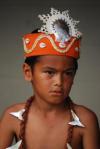- An eager welcome at the airport.
- Transportation to Atiu, courtesy of Air Raro.
- Mere, our unofficial guide.
- A friendly face.
- Birdman George in the jungle.
- A frigate bird in flight above Atiu.
I recently had the opportunity to visit the island of Atiu.
Of the 15 specks of land that comprise the Cook Islands, Atiu (pronounced AT-CHEW) is ranked third – behind Rarotonga and Aitutaki – in terms of population and development. As such, it is very much on the radar as a destination project for the Cook Islands Tourism Corporation.
When the CITC invited a group of nearly 30 travel industry types to the Cook Islands – in a marketing effort designed to spread the gospel of this tropical paradise – and a day trip to Atiu was added to the itinerary, I put my hand up to cover the event for the Cook Islands Herald.
It’s been 10 years since I was last on Atiu. Nothing much had changed. And that’s a good thing. Development is fine but, sometimes, you can develop the character right out of a place.
The airport terminal is still little more than an open-sided building with a roof. The cheeky sign – the one claiming to be an Atiu Airport Voluntary Security Check and asking passengers to “please hand their AK47s, Bazookas, grenades, explosives and nukes to the pilot on boarding the aircraft” – is still in place.
Our visiting party – flown in aboard two of Air Raro’s turbo props – was greeted by the locals with flower eis and kisses on the cheek. We were then divided into two groups for a tour of the island. I found myself with the larger group – along with Nerys Case of the Cook Islands News – sitting in the back of a truck belonging to George Mateariki, Aitu’s famed “Birdman George.”
George gave us a sample of the tour he provides for tourists, one where we were bounced and jounced over rutted jungle trails (I hesitate to call them “roads”), stopping at intervals so George could point out various bird life and explain the medicinal use of assorted flora. At one point, George skimmied up a palm tree to liberate several coconuts. Using a machete as skillfully as a surgeon’s scalpel, he hacked open the tops of the coconuts without spilling a drop of water and passed them around.
The majority of the passengers grumbled amongst themselves about they’d rather not be sitting there, watching a man climb a tree, because their lack of mobility made them easier targets for the swarms of voracious mozzies. Nerys and I watched in bemused silence. Neither of us is a local – Nerys is English; I’m Canadian – but we’d obviously been in the Cook Islands long enough to no longer qualify as fresh meat, because we were virtually ignored when it came to the involuntary blood donation.
The coconut water was refreshing and, much to my surprise, rather on the carbonated side. Not sure how that works. A touch of fermentation? Perhaps.
We stopped for a quick visit with Andrea Eimke at the Atiu Fibre Arts Studio, where we marvelled at the tivaevae – ceremonial quilted bedspreads – on display. Later during our tour, we drove past the coffee plantation run by Andrea’s husband, Juergen Manske-Eimke (known locally as “The German”). All of us gazed longingly at the coffee cherries, hoping – in vain, as it turned out – for a taste of their magic elixir.
Lunch – provided by Birdman George and his helpers – consisted of a variety of local food cooked in an umu, or underground oven. I’m an old hand when it comes to such traditional meals and so knew going in that, while there would be plenty of food, there would be a distinct lack of utensils and napkins. And so I only took what I could eat with my fingers, and sat close to the tap so I could rinse my hands off as soon as I was full.
The afternoon was spent inspecting accommodation properties, so these travel agents and travel agency owners could see first-hand the types of places on offer for their potential customers. Nerys and I hopped out of the truck bed the first few stops, if only to stretch our legs but – honestly – if you’ve seen one room, you’ve seen them all. Eventually, we just stayed in the truck and turned our faces to the sun, soaking up the heat like lizards on a rock.
We were accompanied through most of the day by an Australian girl of maybe nine or 10, named Mere. Mere’s mother informed us that, yes, Mere should have been in school but woke up that morning feeling a bit on the crook side. Until, that is, she heard two planes filled with visitors were about to land and then – it’s a miracle! – she suddenly felt a whole lot better.
Mere – all toothy grin and red hair – was so thrilled to see us that she acted as a one-person welcoming committee all on her own. It didn’t matter that she wasn’t technically a native of Atiu – or even a Cook Islander, for that matter. Her genuine pleasure at seeing our group was a reflection of how everyone on the island greeted us.
Yes, there are rare birds to be seen on Atiu. And you really must swim in the sea caves. And tramp through unspoiled jungles. Or drink the home brew that will take the hair right off your tongue. But, in the end, it’s not the scenery or attractions that make a place special for me.
It’s the people.
Atiu hasn’t changed much in 10 years. Neither has the sunny attitude of its population. And that’s a good thing.


























